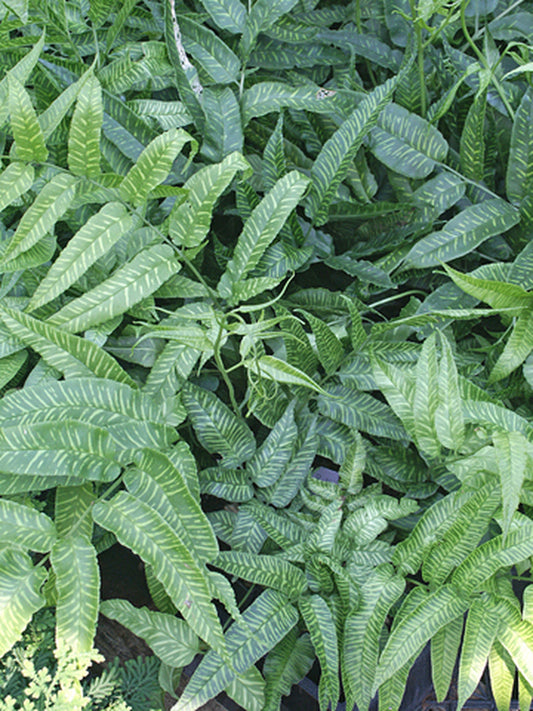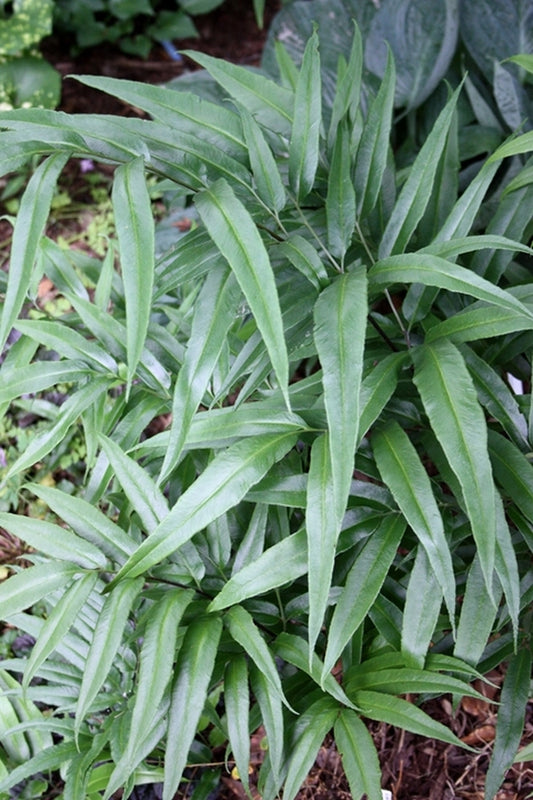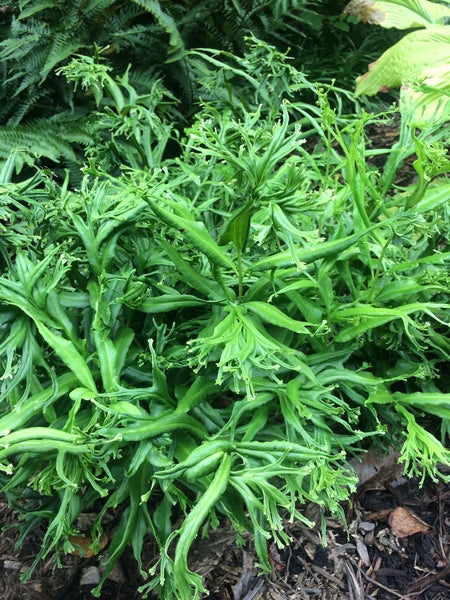Coniogramme is a group of mostly Asian ferns that has a uniquely tropical appearance and has become one of our favorite genera of hardy garden ferns. In our temperate garden, Coniogramme has performed well for years. While the genus Coniogramme is mostly stoloniferous, it is quite slow to spread, forming a fantastic patch.
Coniogramme is quite tough as a garden plant, prefering partial shade and tolerating a wide variety of soils. Coniogramme fronds can be quite tall and in some cases are variegated with small yellow stripes. The leathery fronds are also deer-resistant. Coniogramme is an exotic-looking coarse-textured fern and looks great when paired with hosta, selaginella, fatsia, or with other ferns. If you're ready to buy Coniogramme ferns for your woodland garden, check out our online list of Coniogramme for sale.
-
 Sold out
Sold outConiogramme emeiensis 'Golden Zebra'
Item #: 6949
Zones: 7b to 9b, at least
Dormancy: Winter
Height: 24" tall
Culture: Part Sun to Light Shade
Origin: China
Pot Size: 3.5" pot (24 fl. oz/0.7 L)
Regular price $25.00Regular priceUnit price per -
 Sold out
Sold outConiogramme japonica
Item #: 4877
Zones: 7b to 9b, at least
Dormancy: Winter
Height: 24" tall
Culture: Light Shade to Shade
Origin: China, Japan, Korea
Pot Size: 3.5" pot (24 fl. oz/0.7 L)
Regular price $24.00Regular priceUnit price per -
Coniogramme jinggangshanensis 'Shishi'
Item #: 9304
Zones: 7b to 10b
Dormancy: Winter
Height: 24" tall
Culture: Part Sun to Light Shade
Origin: China, Japan
Pot Size: 3.5" pot (24 fl. oz/0.7 L)
Regular price $25.00Regular priceUnit price per
More Information About Coniogramme
Coniogramme is a genus of roughly 20 species that is primarily distributed in Asia, Africa, and Oceania. This group has a uniquely bold tropical appearance and has become one of our favorite genera of ferns. While the genus is mostly stoloniferous, they are slow to spread, making fantastic garden specimens. The genus name is derived from the ancient Greek ‘konios’ meaning dusty and ‘gramme’ meaning line. The spore bearing structures (sori) of this fern are borne in attractive lines on the underside of the frond.
Coniogramme (Bamboo Fern) Growing Conditions
We have tried bamboo ferns in both dry and wet woodland soils and have had equal success in both. In the wild, they can often be found growing in upland, dry soils, but in dry soils, be sure they are watered well during the establishment period. A slightly open woodland with filtered light gives better results than very dark shade. For us, they are tardily deciduous often looking good until very cold weather sets in during mid-winter. In warmer zones they may hold their leaves in good condition year-round.
Coniogramme (Bamboo Fern) Maintenance
In the Southeast these species tend to be care-free but in the Pacific Northwest and western Europe beware of slugs. Slugs seem to have a special fondness for these plants, and one needs to take extra care to make sure the young fronds don’t become a slug feast.
Coniogramme Species
Coniogramme emeiensis (Striped Mt. Emei Bamboo Fern) This amazing form of the bamboo fern comes from China's magical Mt. Emei (also spelled Omei). Coniogramme emeiensis makes a stunning 18” tall patch of branched ribbon-shaped leaves, each highlighted with horizontal yellow bands, most pronounced in the new growth. So far, this has been hardy to 9º F in our trials. Where it isn't hardy, it will make one really cool houseplant! (Hardiness Zone 7b-9 at least)
Coniogramme gracilis (Narrow-leaf Bamboo Fern) Recently elevated to species status, (formerly C. japonica var. gracilis) this unique fern has been a standout in our garden for the past 5 years. In our Zone 7b garden, narrow leaf bamboo fern has made a nice 3' wide clump in 5 years. It may spread faster in warmer climates. The glossy, evergreen, narrow, ribbon-like foliage resembles anything except a fern as it makes a dense clump. C. gracilis forms a tighter clump and possesses a narrower leaf with a more pendant form than typical Coniogramme japonica. (Hardiness Zone 7b-9 at least)
Coniogramme intermedia (Intermediate Bamboo Fern) In form, this species is very similar to C. japonica, but for us, this has been more vigorous. Our 5-year-old clumps are now 5’ wide x 2’ tall. A robust and bold choice for any woodland garden where it is very well-behaved and striking.
Coniogramme intermedia ‘Yoroi Musha' (Yoroi Musha Bamboo Fern) This unique Japanese selection has terminal pinnae that are deeply cut. (Hardiness Zone 7b-9)
Coniogramme intermedia ‘Rasha’ (Narrow Crested Bamboo Fern) This Japanese form has very narrow, slightly contorted pinnae. (Hardiness Zone 7b-9)
Coniogramme jinggangshanensis ‘Shishi’ (Shishi Crested Bamboo Fern) This crested Japanese selection is the least vigorous form that we have grown, but it makes a truly stunning specimen with large terminal twisted crests. (Hardiness Zone 7b-10b)
Coniogramme japonica (Japanese Bamboo Fern) Bamboo fern is a unique bold-textured fern with upright, 2' tall, dark green, plastic-feeling fronds held on a shiny black stipe and emerging from a slowly spreading rhizome. For us, a 10-year-old clump is 3' wide. Where we have seen this growing in the wild, it seems to prefer a moist to slightly moist woodland soil. A choice and bold plant that is very easy to grow. (Hardiness Zone 7b-9 at least)
Coniogramme affinis 'Ping Wu' (Ping Wu Bamboo Fern) This Hans Hansen collection hails from Ping Wu in China's Sichuan province at 5,000' elevation. The 3' long, dark green, glossy tripinnate fronds arch outward to form a 2' tall by 3' wide plant in 3 years. The thick underground rhizomes spread outward, but not at a rate that will prove scary or invasive in the woodland garden. We previously sold this fern as C. venusta but were able to determine this remarkable fern is actually a representative of C. affinis. (Hardiness Zone 7b-10 at least)






